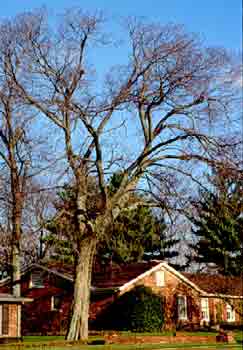 Sugar Hackberry - Celtis laevigata
Sugar Hackberry - Celtis laevigata
Elm Family (Ulmaceae)
This tree has weak wood that breaks under the stresses of snow, ice and wind. Although sugar hackberry has been used as a street tree in many cities in the South, its use has been banned by other cities because of problems with trunk rot. Wildlife, particularly birds and squirrels, enjoy and seek out hackberry's nutritious fruits. However, these fruits can develop abundant seedlings that can become a weed pest.
- Native habitat: Southern Indiana and Illinois south to Florida and Texas.
- Growth habit: This tree has a rounded crown with spreading, pendulous branches.
- Tree size: This species reaches a height of 60 to 80 feet at maturity, with a similar spread.
- Flower and fruit: Small male, female and bisexual flowers are borne on the same plant. Edible, berry-like fruit is orange-red to blue-black and sweet.
- Leaf: The dark green leaves are 2 to 4 inches long. Fall color is yellow.
- Hardiness: Winter hardy to USDA Zone 5; C. occidentalis is hardy to Zone 3.
Common hackberry (C. occidentalis) tolerates most difficult sites and is native from Canada to Georgia including Kentucky. It differs from sugar hackberry in that the leaves are toothed and not smooth. Common hackberry is more susceptible to an unsightly witches-broom, which can disfigure branches but does not seriously affect the health of the tree. It is also susceptible to galls, caused by insects called psyllids, that can disfigure the leaves. The effect is cosmetic only and does not warrant control. Several cultivars of common hackberry are available with either a single leader or more resistance to witches-broom These include ‘Chicagoland,' ‘Delta' and ‘Prairie Pride.'
The sugar hackberry genus name, Celtis, is the Greek name for a tree bearing sweet fruit. The species name, laevigata, means "smooth," referring to the smooth leaves. The fruit of this species was used as a food seasoning by Native Americans and early settlers. The fruit floats in water and is waterborne in nature where the tree grows along streams and on river plains. Sugar hackberry wood is soft and weak. It has a limited use because of its lack of strength. The national champion sugar hackberry tree is 81 feet tall and is in South Carolina.



